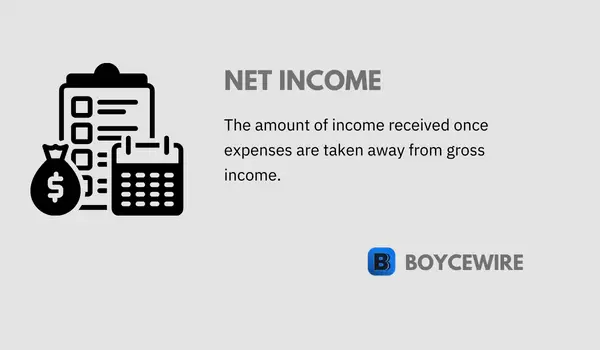Net Income: Definition, Formula & Example

What is Net Income
Net income (NI) is the amount of income an individual or business receives, minus any expenses. For individuals, this takes into account expenses such as tax, pension contributions, and student loan re-payments. For businesses, the NI would be its revenue minus its various expenses such as salaries, inputs, rent, utilities, as well as the various taxes due.
It is easy to get gross income and NI confused. The main difference is that gross income is the total income. It’s fresh and untouched. So that is before taxes and other costs are taken into account. By contrast, NI is AFTER tax and other deductions.
Key Points
- Net Income (NI) is the total income received after expenses including but not limited to taxation.
- NI can be calculated using the formula: NI = total revenue – expenses – taxes, interest, depreciation, and amortization.
- NI is often interchangeable with terms such as net profit and net earnings.
NI is often used in a business context to refer to the amount it receives after expenses. This includes all it’s expenses such as salaries, rent, utilities, and insurance. However, it also includes expenses such as taxes, depreciation, and amortization.
NI is also used interchangeably with other terms such as ‘net profit’, ‘net earnings’, and ‘net pay’. These essentially all mean the same thing, although ‘net profit’ has more of a business context, whilst ‘net pay’ is more of an individual reference.
Net Income Formula
In order to calculate net income (NI), you need to take the firms total revenue and subtract all it’s business expenses. These could include expenses such as insurance, salaries, rent, utility bills, subscription services, and raw materials. Once these are taken away from total revenue, we have what is known as EBITDA (Earnings Before Interest, Taxes, Depreciation, and Amortization).
So in order to calculate NI, we take expenses away from total revenue and then further subtract interest, taxes, depreciation, and amortization. In a large number of cases, this will just be tax. Although capital intensive organizations will also have significant sums of depreciation and amortization.

For individuals, the NI calculation is far more straight forward. It’s purely total income minus taxes.
Net Income Example
Let’s take an example of net income (NI). Bob’s Bakery sells a selection of baked goods ranging from doughnuts to bread. The store is quite popular and makes over $750,000 per year, which is known as total or gross revenue.
It has a number of expenses which include, $100,000 for rent, $10,000 in utilities, $225,000 for staff, and $200,000 for its raw materials such as egg, milk, butter etc. There are other miscellaneous costs such as insurance, window cleaning, and bleach that add up to $5,000. This adds up to make its total running expenses $540,000.
That leaves the firm with a gross profit of $210,000. However, it must pay tax on this as well. If we take a corporation tax rate of 21 percent, this means it would have to pay $44,100 in tax.
Once we minus this away from the firms gross profit, we end up with its NI ($210,000 – $44,100 = $165,900).
- Gross Revenue = $750,000
- Expenses = $540,000
- Gross Profit = $210,000
- Tax = $44,100
- NI = $165,900
Net Income vs Gross Income
Gross income is the total revenue an individual receives before any taxes or other expenses are taken away.
By contrast, net income(NI) is the total profit that a business or individual makes once all expenses and taxes have been taken away. From a business point of view, this would include common expenses such as salaries, rent, and input costs. However, NI also factors in costs such as tax and depreciation.
To put it into perspective, we can see ‘net income’ as an actual net. Anything that falls through the net is income. Expenses like tax and salaries will get caught by the net.
For a business, a positive value will indicate that it has made a profit. If it’s a negative value, then the business makes a loss. What can be alarming for a business is when the difference between gross income and NI is significantly large. This shows that the business has many expenditures, which may have an impact on the underlying profit. If this varies significantly from year to year, the business may seek to review its expenses and payment structure.
Net Income vs Net Profit
There is no difference between NI or net profit. Even other terminology such as net earnings mean exactly the same thing. Accountants often use these terms interchangeably as they are all mean the total revenue that is left over after expenses. This also includes taxes, depreciation, interest expenses, and amortization.
FAQs
NI is the final money left over once expenses and tax is taken away from total revenue/income. Essentially its the money that is left over.
Gross income is the amount of income made before any expenses are taken into consideration. By contrast, NI is gross income minus expenses such as salaries and rent, as well as taxes.
It is the salary after taxes are taken into consideration. This is your take home pay once government has taken its share of the pie.
About Paul
Paul Boyce is an economics editor with over 10 years experience in the industry. Currently working as a consultant within the financial services sector, Paul is the CEO and chief editor of BoyceWire. He has written publications for FEE, the Mises Institute, and many others.

Further Reading
 Why is Communism Bad - Critics of communism argue that it often leads to authoritarianism, inefficiency, lack of incentives, and human rights abuses, making it…
Why is Communism Bad - Critics of communism argue that it often leads to authoritarianism, inefficiency, lack of incentives, and human rights abuses, making it…  Discount Rate in Economics - The discount rate is the interest rate by which the central bank charges commercial banks to borrow money or cover…
Discount Rate in Economics - The discount rate is the interest rate by which the central bank charges commercial banks to borrow money or cover…  Economic Incentives: What it is, Types & Examples - In economics, incentives are what drives consumer and business behaviour.
Economic Incentives: What it is, Types & Examples - In economics, incentives are what drives consumer and business behaviour. 
